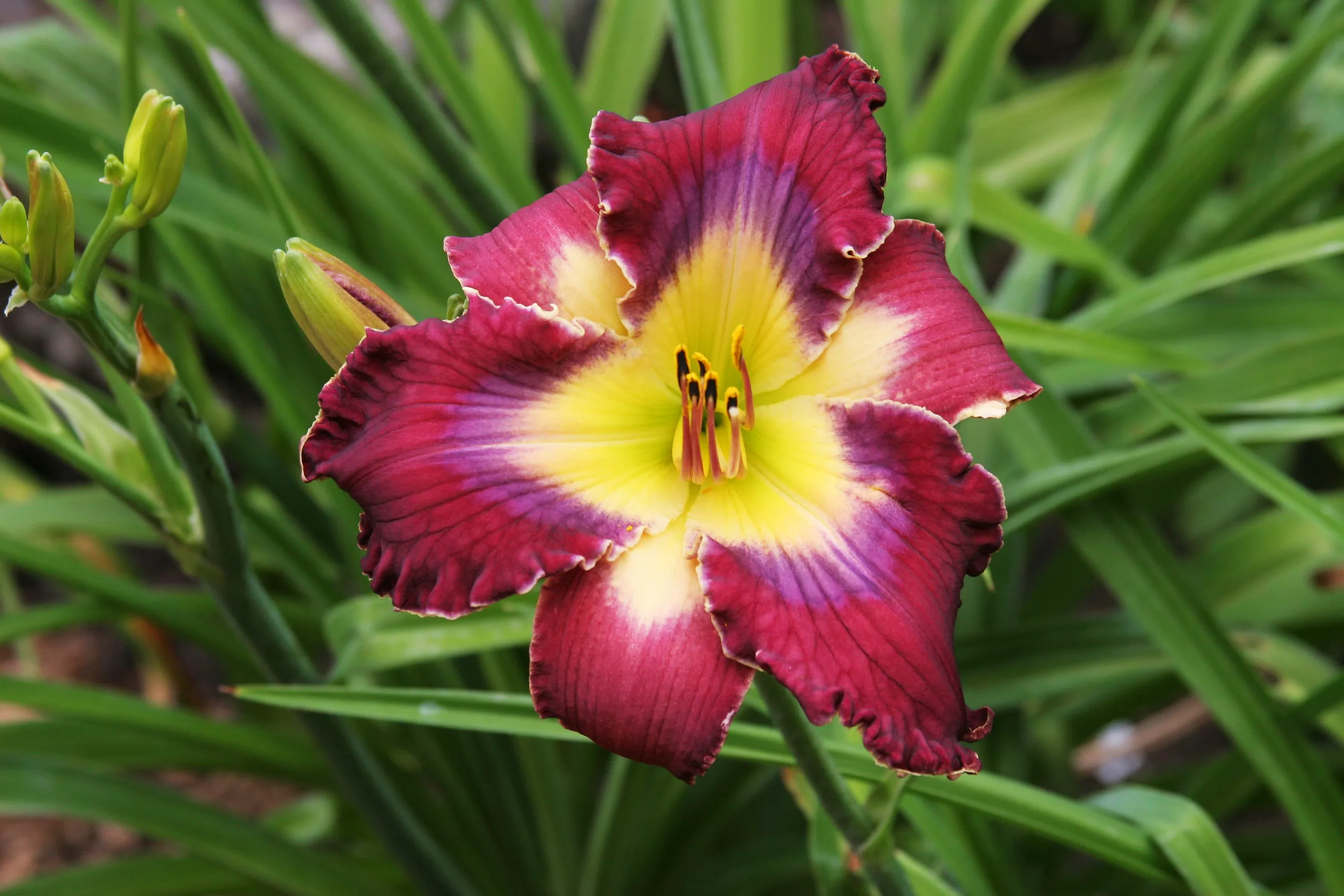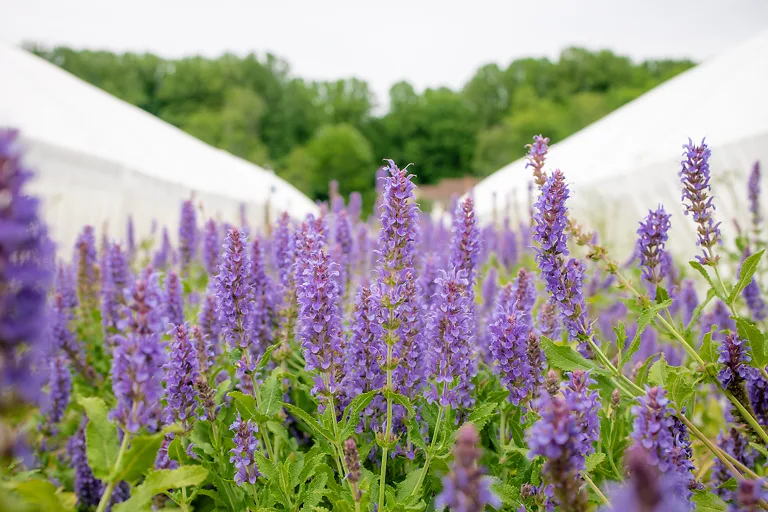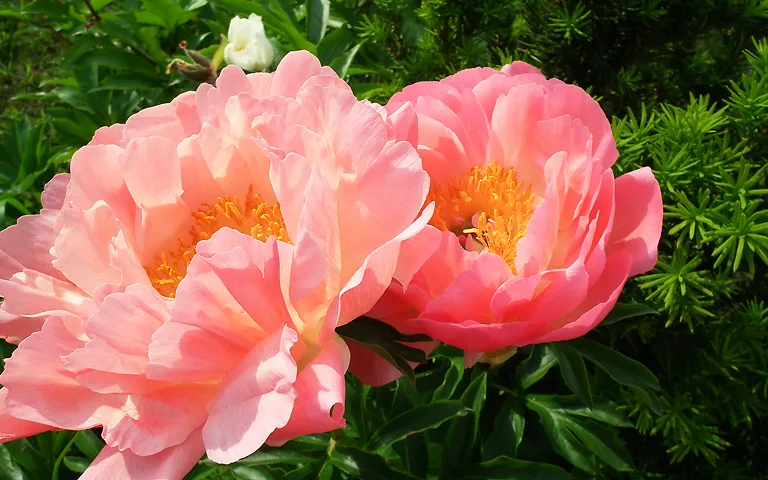
Written by s • What are Tetraploid Daylilies?
Daylilies are among the most beautiful of summer perennials, and what makes them so fascinating is the endless number of different colors, sizes and flower forms they come in. Starting with just a handful of wild species, breeders – mostly amateur – have created literally thousands of new forms – around 90,000 at a recent count. Once you start taking an interest in daylilies, it won’t be long before you see that some are described as ‘diploid’, and some as ‘triploid’, while others are ‘tetraploid’, so what is that all about? To help out, I am going to explore this issue, so that it will be clear, and discuss the benefits of this ‘condition’ in daylilies, and also in other important plants – including, in fact, the wheat that is in the slice of bread you probably had for breakfast.
What is a Tetraploid?
First of all, we need to start with cells. Like us, plants are made of cells, which differ mostly from ours in being inside little cellulose boxes that make the structure of the plant. Like ours, they have a nucleus, the ‘control center’ of the cell, where instructions are stored and sent out. Inside the nucleus are the genes, which everyone knows decide pretty much everything about how a living thing looks and acts. These genes are organized on structures called chromosomes, and as a kind of ‘safety precaution’, at most stages of a plant’s life these chromosomes, and so the genes on them, are duplicated – chromosomes come in matching pairs. Plants have different numbers of pairs, and most daylilies have a basic number of 22 – 11 pairs of chromosomes. Here they are.
Tetraploid Plants are More Common than You Think
In animals and humans, having extra chromosomes is usually bad, but not in plants. Having multiple copies, instead of just two, is an important part of the evolution of plants, and it’s estimated that between 30% and 80% of all plants on the planet have multiple chromosomes. For us, this includes some of our most important crop plants – wheat, oats, peanuts, bananas, strawberries, coffee, and potatoes – t name just a few. So learning that the daylilies in your garden are like this too is not really surprising, scary or ‘sci-fi’. It isn’t the result of some mad, planet-destroying scientist, either, as most daylily breeders are just dedicated gardeners.
Polyploids and other Fun Numbers
Most people are aware that when organisms breed, the cells that combine – pollen and the immature seed in plants – have gone through divisions that reduce the number of chromosomes to one of each in these gametes. But that doesn’t always happen. Sometimes the chromosomes don’t divide properly, and pollen or seeds can have extras. Different numbers of chromosomes are possible – and commonly found – in plants. In those gametes, the normal number is one of each, called haploid. The normal double pair formation is called diploid. If you have three of each, that’s a triploid. Four of each is a tetraploid. You can also have pentaploid (5) or hexaploid (6). Even higher numbers are possible – strawberries can be octaploid (8), or decaploid (10). Durum wheat, the best type for bread, is a hexaploidy. All of these except for diploid are collectively called polyploids.
Is Polyploidy Good for Plants?
Polyploidy gives great advantages to plants. They are often more vigorous, and so can survive where their parents can’t. It’s been an important way plants have colonized harsher and harsher environments, like deserts, high mountains, or polar regions. It often makes all the parts of the plant bigger, so for wheat the seeds are bigger, and so make better food. For gardens, the flowers are bigger, with thicker petals that have more ‘substance’, brighter colors, longer lasting, and so on. No wonder so many plants, including the daylilies we are focusing on, are polyploids. There doesn’t seem to be a ‘downside’ for plants either, that’s why it has become such an important part of their evolution. Indeed, there are biologists in this field who believe that higher animals too, which today are exclusively diploid, were once polyploid, and that was an important driver of their evolution in the past, before ‘stabilizing’ as diploid.
Creating Tetraploid Plants
As it does in nature, polyploidy happen by chance, but for garden daylilies it was first done using a chemical called colchicine. That is derived from a bulb, the autumn crocus, called botanically Colchicum. This plant might be familiar to you are autumn crocus, or naked ladies, because the bulbs will bloom out of the soil, sitting on a windowsill. They have purple flowers like a crocus, and the colchicine in them makes then poisonous. For that reason farmers try to eliminate them if they appear in their fields. It is also very dangerous for people, and must be used under laboratory conditions – not at the kitchen sink! It is used in very low concentrations for treating plants, often around a 0.2% solution – that’s 1 part of colchicine in 500 parts of water. For some treatments it can be a tenth of that.
Colchicine affects the process you probably learn in high school, called mitosis. This is the doubling of chromosomes that takes place during cell division. Colchicine blocks the later stages of mitosis, so that chromosomes double, but the cell doesn’t divide, leaving a tetraploid cell, which when it divides, remains tetraploid. This effect was discovered in 1937, and by the 1940s Robert Schreiner, W. Quinn Buck, and Hamilton Traub were all working on daylilies, creating the first tetraploids around 1948. You can induce tetraploids in different ways in daylilies. Sometimes the shoots of growing plants are treated. Seeds and seedlings are also treated by soaking them in colchicine for a short period of time. As they continue to grow the new plant may develop as tetraploid. All this early work was carried out at either Universities of Federal Department of Agriculture labs, spreading later among amateur breeders and nursery owners.
The process of creating viable tetraploid daylilies this way is not easy. Sometimes the plants are only partly tetraploid – nicknamed ‘mixaploids’. They are usually sterile be sterile – producing no seeds – or almost sterile. Luckily, once a few generations of breeding has been done (with great difficulty), the tetraploids start to produce seeds more or less normally, making it much easier for amateurs to develop new varieties with them.
Triploid Daylilies
If you cross together two tetraploid varieties, you get another tetraploid, but if you cross a tetraploid with a diploid, the resulting plant has three copies of each chromosome, so it is a triploid. Since it is very hard to create viable pollen or seeds from these plants – you can’t divide three into two – they are almost always sterile, so they can’t be used for further breeding.
Among the very first daylily plants to arrive in Europe was a plant knowns correctly today as Hemerocallis fulva ‘Europa’. This is the common ‘wild’ daylily, with tall stems and orange flowers, found in almost every old garden and growing in many ditches and fields across America. It turns out to be a triploid, so it is sterile. It’s hard to get our heads around the idea that every one of those plants you see has spread from pieces of the plant, not from seeds.
Studies of wild plants in China show that 45% of wild plants can be triploid, which explains why ‘Europa’ could have been collected in the wild, and yet be triploid. It would seem that natural tetraploid daylily plants are relatively common, but not common enough for them to likely cross together, since those wild triploid plants must be the result of a tetraploid crossing with a diploid.
Using Tetraploid Daylilies in Your Garden
There are pluses and minuses about growing tetraploid varieties of daylilies in the garden. They have broader, thicker leaves, larger flowers, brighter colors, and more ‘substance’. They may bloom over a longer period. However there may be fewer flowers on a spike, and plants take longer to establish, and spread more slowly. So it depends on what you want. These plants are great for specimens, but if you want daylilies to fill larger areas, as ground cover, then stick to vigorous diploids, like the well-known ‘Stella de Oro’.







